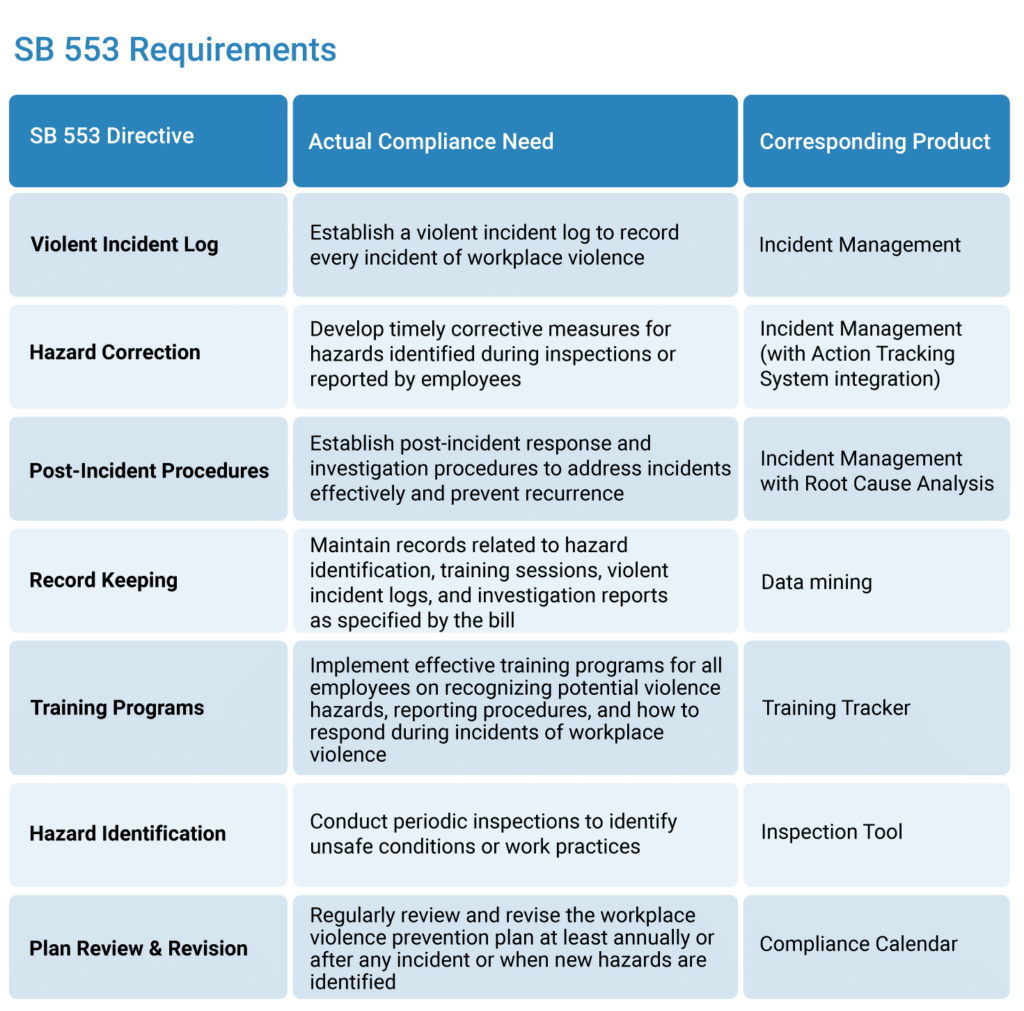On July 1, 2024, Senate Bill 553 (SB 553), California’s new Workplace Violence Prevention Plan Law, takes effect, introducing key enhancements in workplace safety regulations. This legislation emphasizes the importance of safeguarding employee well-being across most California businesses, with specified exemptions for certain healthcare facilities and non-public workplaces with fewer than ten employees.
Understanding and complying with SB 553 is vital to avoid potential Cal/OSHA citations, fines, or legal issues. The law aims to bolster safety measures, focusing on preventing workplace violence. As responsible employers, you are encouraged to proactively manage safety incidents through comprehensive incident management strategies, ensuring rapid and efficient resolution. This adheres to legal requirements and demonstrates your commitment to employee safety and well-being.
What is SB 553?
In response to the growing workplace violence, SB 553 emerges as California’s strategic measure to strengthen employee protection across industries. This pivotal legislation comprises stringent guidelines and protocols to foster a safe work environment, demonstrating your commitment to enhancing safety standards.
The introduction of this law emphasizes the importance of staying in compliance, with penalties for not complying that include fines between $18,000 and $25,000 per incident. This approach highlights the necessity for your organization to take active steps towards making your workplace safer and more supportive, directly responding to the increasing incidents of workplace violence.
How To Comply With SB 553
To align with SB 553 effectively and efficiently, adopting a strategic approach to enhancing workplace safety against violence is crucial. Here are the requirements you need to prepare:
- Develop a Comprehensive Workplace Violence Prevention Plan (WVPP): Your plan should be detailed and outline responsibilities, hazard identification and assessment, corrective procedures, safety training, a reporting system free from retaliation, and compliance measures. The WVPP may also be added to your existing Injury and Illness Prevention Program (IIPP).
- Mandatory Employee Training: By July 1, 2024, and annually after that, ensure employees are trained on recognizing, preventing, and responding to workplace violence. Training elements should include:
- An introduction to the WVPP and participation methods.
- Reporting processes ensure anonymity and protection from retaliation.
- Role-specific hazards, prevention techniques, and response strategies.
- Accessibility to violent incident logs and records.
- Opportunity for interactive discussions with employees.
- Updates when new hazards are identified.
- Documentation of training details such as dates, content, and attendance.
- Maintain a Workplace Violence Incident Log: Log incidents categorically, based on the nature of the violence and the relationship between the offender and the workplace, without including personal identifiers.
- Adhere to Recordkeeping Requirements: Compliance necessitates meticulous record-keeping for an extended period:
- Hazard identification, evaluations, and corrective actions for five years.
- Incident investigations for five years.
- Violent incident logs for five years.
- Training records for at least one year.
By diligently documenting incidents, training sessions, and updates to your WVPP, you will demonstrate a commitment to regulatory adherence and proactive safety management, safeguarding your workforce against workplace violence.
In the table below, you can see each SB 553 directive, and the Benchmark Gensuite solutions that can easily help you meet it, including Incident Management Software (with Action Tracking System), Training Tracker, Inspection Tool, and Compliance Calendar.

Benefits of Proactive Incident Management
Streamlining your incident management with transparent reporting, swift corrective actions, and diligent injury documentation isn’t just good practice—it’s at the heart of SB 553 and essential for a safer workplace. This strategy empowers employees to swiftly flag any safety concerns, hazards, or near misses, creating a proactive culture that prevents accidents before they escalate.
Employers can ensure that reported issues are addressed promptly and effectively with a structured system, maintaining accountability and enhancing safety. Moreover, immediate documentation of injuries is crucial, facilitating rapid response and initiating a thorough investigation to prevent future incidents. Adopting these proactive measures allows businesses to identify and resolve safety issues promptly, minimize workplace injuries, and comply with legal mandates, fostering a secure and healthy work environment for everyone.
Comprehensive Safety in SB 553 Compliance
With SB 553 taking effect on July 1 in California, sharpening your safety protocols is non-negotiable. Dive deep into the requirements, from a meticulous violence prevention plan to full-scale employee safety training and ensuring necessary resources are available for successful implementation.
Staying ahead means adopting a proactive stance on compliance. Leverage tools and processes that streamline your safety management, ensuring you can tackle issues quickly and effectively. Make workplace safety and compliance to SB 553 a hallmark of your operation, showcasing your unwavering commitment to your team’s well-being and setting a gold standard in safety practices.
Learn more about California SB 553, with our comprehensive guide.
Simplify and Streamline Workplace Safety
An effective incident management program is essential and strategic for any organization. Benchmark Gensuite’s software streamlines incident management, enhancing safety and leading to a proactive and safer future. By managing incidents thoroughly, we help protect your most valuable asset—your employees. Request a demo to learn more about how our incident management solutions can benefit your organization.



